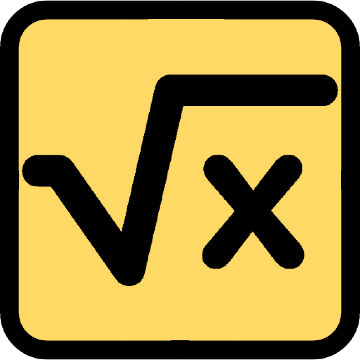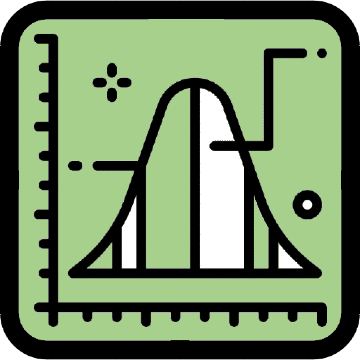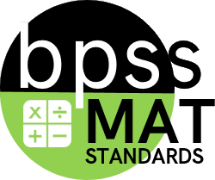MAT-02.AR  MAT-02.AR MAT-02.AR Domain  | (AR) Number and Operations Learners will develop a foundational understanding of the number system, operations, and computational fluency to create connections and solve problems within and across concepts.
|
Sub-Categories- (OA) Operations and Algebraic Thinking
Learners will analyze patterns and relationships to generate and interpret numerical expressions. - (RP) Ratios and Proportional Relationships
Learners will use ratios, rates, and proportions to model relationships and solve problems. - (EE) Expressions and Equations
Learners will look for, generate, and make sense of patterns, relationships, and algebraic symbols to represent mathematical models while adapting approaches in novel situations.
- (F) Functions
Learners will develop a foundational knowledge of functions and use them to model relationships between quantities.
Calculation Method for DomainsDomains are larger groups of related standards. The Domain Grade is a calculation of all the related standards. Click on the standard name below each Domain to access the learning targets and rubrics/ proficiency scales
for individual standards within the domain. |
|
MAT-02.AR.OA.01

|
2nd Grade (MAT) Targeted Standard
(AR) Algebraic Reasoning
(OA) Operations and Algebraic Thinking
Learners will analyze patterns and relationships to generate and interpret numerical expressions.
|
MAT-02.AR.OA.01 Automatically add and subtract within 20.
 Proficiency Scale Proficiency Scale
Progressions
Operations – Basic Facts
- MAT-00.AR.OA.01 Automatically add and subtract within 5.
- MAT-01.AR.OA.01 Automatically add and subtract within 10.
- MAT-02.AR.OA.01 Automatically add and subtract within 20.
- MAT-03.AR.OA.01 Using mental strategies, multiply and divide basic facts within 100. Automatically multiply and divide up to 5 x 5 and 10s facts.
- MAT-04.AR.OA.01 Automatically multiply and divide through 10 x 10.
- MAT-05.AR.OA.01 Automatically multiply and divide through 12 x 12.
|
|
MAT-02.AR.OA.02

|
2nd Grade (MAT) Targeted Standard
(AR) Algebraic Reasoning
(OA) Operations and Algebraic Thinking
Learners will analyze patterns and relationships to generate and interpret numerical expressions.
|
MAT-02.AR.OA.02 Apply the properties of operations to solve addition and subtraction equations within 100 and justify thinking.
 Proficiency Scale Proficiency Scale
Progressions
Properties of Operations
- MAT-02.AR.OA.02 Apply the properties of operations to solve addition and subtraction equations and justify thinking.
- MAT-03.AR.OA.02 Apply the properties of operations to solve multiplication and division equations and justify thinking.
- MAT-04.AR.OA.02 Identify and apply the properties of operations for addition, subtraction, multiplication, and division and justify thinking.
- MAT-05.AR.OA.02 Analyze problems using the order of operations to solve and evaluate expressions while justifying thinking.
- MAT-06.AR.EE.03 Identify when two expressions are equivalent. Apply the properties of operations to generate equivalent expressions.
- MAT-07.AR.EE.01 Apply properties of operations as strategies to add, subtract, factor, and expand linear expressions involving variables, integers, and/or non-negative fractions and decimals with an emphasis on writing equivalent expressions.
- MAT-08.AR.EE.05 Solve linear equations with rational number coefficients and variables on both sides, including equations that require using the distributive property and/or combining and collecting like terms. Interpret the number of solutions. Give examples of linear equations in one variable with one solution, infinitely showing solutions or no solutions.
- MAT-09.AR.05 Justify each step in solving a linear equation that may or may not have a solution.
Equations/Expressions
- MAT-01.AR.OA.06 Use the +, -, and = symbols accurately in an equation.
- MAT-02.AR.OA.02 Apply the properties of operations to solve addition and subtraction equations and justify thinking.
- MAT-03.AR.OA.02 Apply the properties of operations to solve multiplication and division equations and justify thinking.
- MAT-03.AR.OA.03 Solve word two-step authentic word problems using addition and subtraction within 1000, including equations with a letter as an unknown.
- MAT-03.AR.OA.04 Use strategies and visual models to solve authentic word problems with multiplication within 100, including unknowns, using grouping models and equations.
- MAT-03.AR.OA.05 Use strategies and visual models to solve authentic word problems with division within 100, including unknowns, using grouping models and equations.
- MAT-04.AR.OA.03 Solve multi-step authentic word problems using the four operations, including problems with interpreted remainders.
- MAT-04.AR.OA.05 Interpret multiplication equations as a comparison. Represent multiplicative comparisons as multiplication equations.
- MAT-05.AR.OA.02 Analyze problems using the order of operations to solve and evaluate expressions while justifying thinking.
- MAT-05.AR.OA.03 Write simple expressions that record calculations with numbers. Interpret numerical expressions without evaluating them.
- MAT-06.AR.EE.01 Write, read, and evaluate numerical expressions, including expressions with whole number exponents and grouping symbols.
- MAT-06.AR.EE.02 Read and evaluate algebraic expressions, including expressions with whole number exponents and grouping symbols. Write algebraic expressions to represent simple and authentic situations.
- MAT-06.AR.EE.04 Describe the concept of a solution of an equation or an inequality. Determine whether a given number is a solution to an equation or an inequality.
- MAT-06.AR.EE.05 Write and solve equations of the form of x + p = q and px = q for cases in which p and q are non-negative whole numbers or decimals, including authentic problems.
- MAT-07.AR.EE.02 Write and solve equations of the form px + q = r and p(x + q) = r , including in authentic problems.
- MAT-08.AR.EE.01 Explain the relationship between repeated multiplication and the properties of integer exponents. Apply a single exponent property to generate equivalent numeric and algebraic expressions that include numerical coefficients.
- MAT-08.AR.EE.02 Use square root and cube root symbols to represent solutions to equations of the form x² = p and x³ = p, where p is a non-negative rational number.
- MAT-08.AR.EE.06 Read, write, and evaluate numerical and algebraic expressions, including expressions involving absolute value. Solve and graph equations of the form |x| = r where r is a nonnegative rational number.
- MAT-09.AR.01 Use the structure of an expression (i.e., quadratic and exponential) to identify ways to rewrite it.
- MAT-09.AR.04 Create linear and exponential equations in two or more variables to represent relationships between quantities. Graph equations on coordinate axes with appropriate labels and scales.
- MAT-12.AR.03 Interpret expressions that represent a quantity in context.
- MAT-12.AR.02 Use the structure of an expression (to extend to polynomial and rational expressions) to identify ways to rewrite it.
|
|
MAT-02.AR.OA.03

|
2nd Grade (MAT) Targeted Standard
(AR) Algebraic Reasoning
(OA) Operations and Algebraic Thinking
Learners will analyze patterns and relationships to generate and interpret numerical expressions.
|
MAT-02.AR.OA.03 Solve one- and two-step authentic word problems with addition within 100, including the use of unknowns.*
 Proficiency Scale Proficiency Scale
Progressions
Solve Problems Using Operations
- MAT-00.AR.OA.04 Solve authentic word problems with addition by putting together or adding to within 10.
- MAT-01.AR.OA.06 Use the +, -, and = symbols accurately in an equation.
- MAT-01.AR.OA.04 Solve authentic word problems with addition, including three numbers and unknowns, within 20.
- MAT-02.AR.OA.03 Solve one- and two-step authentic word problems with addition within 100, including the use of unknowns.
- MAT-00.AR.OA.05 Solve authentic word problems with subtraction by taking apart or taking from within 10.
- MAT-01.AR.OA.05 Solve authentic word problems with subtraction, including unknowns, within 20.
- MAT-02.AR.OA.04 Solve one- and two-step authentic word problems with subtraction within 100, including the use of unknowns.
- MAT-02.AR.OA.05 Use repeated addition to find the total number of objects arranged in a rectangular array.
- MAT-03.AR.OA.03 Solve two-step authentic word problems using addition and subtraction within 1000, including equations with a letter as an unknown.
- MAT-03.AR.OA.04 Use strategies and visual models to solve authentic word problems with multiplication within 100, including unknowns, using grouping models and equations.
- MAT-03.AR.OA.05 Use strategies and visual models to solve authentic word problems with division within 100, including unknowns, using grouping models and equations.
- MAT-04.AR.OA.03 Solve multi-step authentic word problems using the four operations, including problems with interpreted remainders. Represent problems using equations, including a symbol as an unknown.
|
|
MAT-02.AR.OA.04

|
2nd Grade (MAT) Targeted Standard
(AR) Algebraic Reasoning
(OA) Operations and Algebraic Thinking
Learners will analyze patterns and relationships to generate and interpret numerical expressions.
|
MAT-02.AR.OA.04 Solve one- and two-step authentic word problems with subtraction within 100, including the use of unknowns.*
 Proficiency Scale Proficiency Scale
Progressions
Solve Problems Using Operations
- MAT-00.AR.OA.04 Solve authentic word problems with addition by putting together or adding to within 10.
- MAT-01.AR.OA.06 Use the +, -, and = symbols accurately in an equation.
- MAT-01.AR.OA.04 Solve authentic word problems with addition, including three numbers and unknowns, within 20.
- MAT-02.AR.OA.03 Solve one- and two-step authentic word problems with addition within 100, including the use of unknowns.
- MAT-00.AR.OA.05 Solve authentic word problems with subtraction by taking apart or taking from within 10.
- MAT-01.AR.OA.05 Solve authentic word problems with subtraction, including unknowns, within 20.
- MAT-02.AR.OA.04 Solve one- and two-step authentic word problems with subtraction within 100, including the use of unknowns.
- MAT-02.AR.OA.05 Use repeated addition to find the total number of objects arranged in a rectangular array.
- MAT-03.AR.OA.03 Solve two-step authentic word problems using addition and subtraction within 1000, including equations with a letter as an unknown.
- MAT-03.AR.OA.04 Use strategies and visual models to solve authentic word problems with multiplication within 100, including unknowns, using grouping models and equations.
- MAT-03.AR.OA.05 Use strategies and visual models to solve authentic word problems with division within 100, including unknowns, using grouping models and equations.
- MAT-04.AR.OA.03 Solve multi-step authentic word problems using the four operations, including problems with interpreted remainders. Represent problems using equations, including a symbol as an unknown.
|
|
MAT-02.AR.OA.05

|
2nd Grade (MAT) Targeted Standard
(AR) Algebraic Reasoning
(OA) Operations and Algebraic Thinking
Learners will analyze patterns and relationships to generate and interpret numerical expressions.
|
MAT-02.AR.OA.05 Use repeated addition to find the total number of objects arranged in a rectangular array.
 Proficiency Scale Proficiency Scale
Progressions
Solve Problems Using Operations
- MAT-00.AR.OA.04 Solve authentic word problems with addition by putting together or adding to within 10.
- MAT-01.AR.OA.06 Use the +, -, and = symbols accurately in an equation.
- MAT-01.AR.OA.04 Solve authentic word problems with addition, including three numbers and unknowns, within 20.
- MAT-02.AR.OA.03 Solve one- and two-step authentic word problems with addition within 100, including the use of unknowns.
- MAT-00.AR.OA.05 Solve authentic word problems with subtraction by taking apart or taking from within 10.
- MAT-01.AR.OA.05 Solve authentic word problems with subtraction, including unknowns, within 20.
- MAT-02.AR.OA.04 Solve one- and two-step authentic word problems with subtraction within 100, including the use of unknowns.
- MAT-02.AR.OA.05 Use repeated addition to find the total number of objects arranged in a rectangular array.
- MAT-03.AR.OA.03 Solve two-step authentic word problems using addition and subtraction within 1000, including equations with a letter as an unknown.
- MAT-03.AR.OA.04 Use strategies and visual models to solve authentic word problems with multiplication within 100, including unknowns, using grouping models and equations.
- MAT-03.AR.OA.05 Use strategies and visual models to solve authentic word problems with division within 100, including unknowns, using grouping models and equations.
- MAT-04.AR.OA.03 Solve multi-step authentic word problems using the four operations, including problems with interpreted remainders. Represent problems using equations, including a symbol as an unknown.
|
|
MAT-02.AR.OA.06

|
2nd Grade (MAT) Targeted Standard
(AR) Algebraic Reasoning
(OA) Operations and Algebraic Thinking
Learners will analyze patterns and relationships to generate and interpret numerical expressions.
|
MAT-02.AR.OA.06 Identify a group of objects from 0 to 20 as even or odd by showing even numbers as a sum of two equal parts.
 Proficiency Scale Proficiency Scale
Progressions
Patterns
- MAT-00.AR.OA.06 Recognize, duplicate, complete, and extend repeating patterns in a variety of contexts (e.g., shape, color, size, objects, sounds, and movement).
- MAT-01.AR.OA.07 Identify, create, complete, and extend patterns that are repeating, increasing, and decreasing in a variety of contexts.
- MAT-02.AR.OA.06 Identify a group of objects from 0 to 20 as even or odd by showing even numbers as a sum of two equal parts.
- MAT-03.AR.OA.06 Identify arithmetic patterns and explain them using the properties of operations.
- MAT-04.AR.OA.06 Generate a number or shape pattern that follows a given rule while identifying apparent features of the pattern that were not explicit in the rule itself.
- MAT-05.AR.OA.05 Generate two numerical patterns using two given rules and form ordered pairs consisting of corresponding terms from the two patterns. (Graphing on a coordinate plane).
- MAT-09.AR.01 Use the structure of an expression (i.e., quadratic and exponential) to identify ways to rewrite it.
- MAT-12.AR.2 Use the structure of an expression (to extend to polynomial and rational expressions) to identify ways to rewrite it.
|
|
MAT-02.DPS  MAT-02.DPS MAT-02.DPS Domain  | (DPS) Data Probability and Statistics Learners will ask and answer questions by collecting, organizing, and displaying
relevant data, drawing inferences and conclusions and making predictions; and understanding and applying basic concepts of probability.
|
Sub-Categories- (D) Data
Learners will represent and interpret data. - (DA) Data Analysis
Learners will ask and answer questions by collecting, organizing, and displaying relevant data, drawing inferences and conclusions, and making predictions. - (P) Probability
Learners will understand and apply basic concepts of probability.
Calculation Method for DomainsDomains are larger groups of related standards. The Domain Grade is a calculation of all the related standards. Click on the standard name below each Domain to access the learning targets and rubrics/ proficiency scales
for individual standards within the domain. |
|
MAT-02.DPS.D.01

|
2nd Grade (MAT) Targeted Standard
(DPS) Data Probability and Statistics
(D) Data
Learners will represent and interpret data.
|
MAT-02.DPS.D.01 Formulate questions and collect,organize, and represent data with up to four categories using single unit scaled picture and bar graphs.
 Proficiency Scale Proficiency Scale
Progressions
Data Collection
- MAT-00.DPS.D.01 Sort and classify objects (up to 10) based on attributes and explain the reasoning used.
- MAT-01.DPS.D.01 Collect, organize and represent data with up to three categories using picture and bar graphs.
- MAT-02.DPS.D.01 Formulate questions and collect, organize, and represent data, with up to four categories using single unit scaled pictures and bar graphs.
- MAT-03.DPS.D.01 Formulate questions to collect, organize, and represent data with more than four categories using scaled pictures and bar graphs.
- MAT-04.DPS.D.01 Formulate questions to collect, organize, and represent data to reason with math and across disciplines.
- MAT-06.DPS.DA.01 Write a statistical question that can be answered using measures of center or variability of a data set.
- MAT-07.DPS.DA.01 Identify the strengths and weaknesses of a population sample, including possible bias in the process of the data collection.
- MAT-12.DPS.06 Use data from a sample survey to estimate a population means or proportion; develop a margin of error through the use of simulation models for random sampling.
- MAT-12.DPS.09 Recognize the purposes of and differences among sample surveys, experiments, and observational studies; explain how randomization relates to each.
Displaying Data
- MAT-01.DPS.D.01 Collect, organize and represent data with up to three categories using picture and bar graphs.
- MAT-02.DPS.D.01 Formulate questions and collect, organize, and represent data, with up to four categories using single unit scaled pictures and bar graphs.
- MAT-03.DPS.D.01 Formulate questions to collect, organize, and represent data with more than four categories using scaled pictures and bar graphs.
- MAT-04.DPS.D.01 Formulate questions to collect, organize, and represent data to reason with math and across disciplines.
- MAT-02.DPS.D.02 Generate data and create line plots marked in whole number units.
- MAT-03.DPS.D.02 Generate data and create line plots marked in whole numbers, halves, and fourths of a unit.
- MAT-04.DPS.D.02 Generate data and create line plots to display a data set of fractions of a unit (1/2, 1/4, 1/8). Solve problems involving addition and subtraction of fractions by using information presented in line plots.
- MAT-05.DPS.D.01 Generate data and create line plots to display a data set of fractions of a unit (1/2, 1/4, 1/8). Use grade-level operations for fractions to solve problems involving information presented in line plots.
- MAT-06.DPS.DA.04 Display numerical data in plots on a number line, including dot plots and histograms. Describe any overall patterns in data, such as gaps, clusters, and skews.
- MAT-09.NO.03 Choose and interpret the scale and the units in graphs and data displays.
- MAT-09.NO.05 Choose a level of accuracy or precision appropriate to limitations on measurement when reporting quantities.
- MAT-10.DPS.01 Represent data with plots on the real number line (dot plots, histograms, and box plots).
- MAT-10.DPS.03 Represent data on two quantitative variables on a scatter plot and describe how the variables are related.
- MAT-10.DPS.10 Construct and interpret two-way frequency tables of data for two categorical variables. Use the two-way table as a sample space to decide if events are independent and approximate conditional probabilities.
- MAT-12.NO.04 Use units as a way to understand problems and to guide the solution of multi-step problems (e.g., unit analysis). Choose and interpret units consistently in formulas. Choose and interpret the scale and the units in graphs
and data displays.
- MAT-12.DPS.04 Represent data on a scatter plot for two quantitative variables and describe how the variables are related.
|
|
MAT-02.DPS.D.02

|
2nd Grade (MAT) Targeted Standard
(DPS) Data Probability and Statistics
(D) Data
Learners will represent and interpret data.
|
MAT-02.DPS.D.02 Identify two-dimensional shapes found within three-dimensional shapes.
 Proficiency Scale Proficiency Scale
Progressions
Displaying Data
- MAT-01.DPS.D.01 Collect, organize and represent data with up to three categories using picture and bar graphs.
- MAT-02.DPS.D.01 Formulate questions and collect, organize, and represent data, with up to four categories using single unit scaled pictures and bar graphs.
- MAT-03.DPS.D.01 Formulate questions to collect, organize, and represent data with more than four categories using scaled pictures and bar graphs.
- MAT-04.DPS.D.01 Formulate questions to collect, organize, and represent data to reason with math and across disciplines.
- MAT-02.DPS.D.02 Generate data and create line plots marked in whole number units.
- MAT-03.DPS.D.02 Generate data and create line plots marked in whole numbers, halves, and fourths of a unit.
- MAT-04.DPS.D.02 Generate data and create line plots to display a data set of fractions of a unit (1/2, 1/4, 1/8). Solve problems involving addition and subtraction of fractions by using information presented in line plots.
- MAT-05.DPS.D.01 Generate data and create line plots to display a data set of fractions of a unit (1/2, 1/4, 1/8). Use grade-level operations for fractions to solve problems involving information presented in line plots.
- MAT-06.DPS.DA.04 Display numerical data in plots on a number line, including dot plots and histograms. Describe any overall patterns in data, such as gaps, clusters, and skews.
- MAT-09.NO.03 Choose and interpret the scale and the units in graphs and data displays.
- MAT-10.NO.05 Choose a level of accuracy or precision appropriate to limitations on measurement when reporting quantities.
- MAT-10.DPS.01 Represent data with plots on the real number line (dot plots, histograms, and box plots).
- MAT-10.DPS.03 Represent data on two quantitative variables on a scatter plot and describe how the variables are related.
- MAT-10.DPS.10 Construct and interpret two-way frequency tables of data for two categorical variables. Use the two-way table as a sample space to decide if events are independent and approximate conditional probabilities.
- MAT-12.NO.04 Use units as a way to understand problems and to guide the solution of multi-step problems (e.g., unit analysis). Choose and interpret units consistently in formulas. Choose and interpret the scale and the units in graphs
and data displays.
- MAT-12.DPS.04 Represent data on a scatter plot for two quantitative variables and describe how the variables are related.
|
|
MAT-02.DPS.D.03

|
2nd Grade (MAT) Targeted Standard
(DPS) Data Probability and Statistics
(D) Data
Learners will represent and interpret data.
|
MAT-02.DPS.D.03 Analyze data and interpret the results to solve one-step comparison problems using information from the graphs.*
 Proficiency Scale Proficiency Scale
Progressions
Data Analysis
- MAT-01.DPS.D.02 Analyze data by answering descriptive questions.
- MAT-02.DPS.D.03 Analyze data and interpret the results to solve one-step comparison problems using information from the graphs.
- MAT-03.DPS.D.03 Analyze data and make simple statements to solve one- and two-step problems using information from the graphs.
- MAT-04.DPS.D.02 Generate data and create line plots to display a data set of fractions of a unit (1/2, 1/4, 1/8). Solve problems involving addition and subtraction of fractions by using information presented in line plots.
- MAT-04.DPS.D.03 Utilize graphs and diagrams to represent and solve word problems using the four operations involving whole numbers, benchmark fractions, and decimals.
- MAT-05.DPS.D.01 Generate data and create line plots to display a data set of fractions of a unit (1/2, 1/4, 1/8). Use grade-level operations for fractions to solve problems involving information presented in line plots.
- MAT-05.DPS.D.02 Utilize graphs and diagrams to represent, analyze, and solve authentic problems using information presented in one or more tables or line plots, including whole numbers, fractions, and decimals.
- MAT-06.DPS.DA.02 Calculate measures of center (median and mean) and variability (range and mean absolute deviation) to answer a statistical question. Identify mode(s) if they exist.
- MAT-06.DPS.DA.03 Identify outliers by observation and describe their effect on measures of center and variability. Justify which measures would be appropriate to answer a statistical question.
- MAT-06.DPS.DA.04 Display numerical data in plots on a number line, including dot plots and histograms. Describe any overall patterns in data, such as gaps, clusters, and skews.
- MAT-07.DPS.DA.02 Analyze and draw inferences about a population using single and multiple random samples by using given measures of center and variability for the numerical data set.
- MAT-08.DPS.DA.01 Interpret scatter plots for bivariate measurement data to investigate patterns such as clustering, outliers, positive or negative association, linear association, and nonlinear association.
- MAT-08.DPS.DA.02 Draw a trend line on a given scatter plot with a linear association and justify its fit by describing the closeness of the data points to the line.
- MAT-08.DPS.DA.03 Solve authentic problems in the context of bivariate measurement data by interpreting the slope and intercept(s) and making predictions using a linear model.
- MAT-08.DPS.DA.04 Construct and interpret a two-way table summarizing bivariate categorical data collected from the same subjects.
- MAT-10.DPS.02 Compare the center (median, mean) and spread (interquartile range, standard deviation) of two or more different data sets using statistics appropriate to the shape of the data distribution.
- MAT-10.DPS.03 Represent data on two quantitative variables on a scatter plot and describe how the variables are related.
- MAT-10.DPS.04 Distinguish between correlation and causation.
- MAT-10.DPS.10 Construct and interpret two-way frequency tables of data for two categorical variables. Use the two-way table as a sample space to decide if events are independent and approximate conditional probabilities.
- MAT-12.DPS.01 Interpret differences in shape, center, and spread in the context of the data sets, accounting for possible effects of extreme data points (outliers).
- MAT-12.DPS.02 Use the mean and standard deviation of a data set to fit it to a normal distribution and estimate population percentages. Recognize that there are data sets for which such a procedure is not appropriate.
- MAT-12.DPS.03 Evaluate reports based on data.
- MAT-12.DPS.04 Represent data on a scatter plot for two quantitative variables and describe how the variables are related.
- MAT-12.DPS.05 Informally assess the fit of a function by plotting and analyzing residuals.
- MAT-12.DPS.06 Use data from a sample survey to estimate a population means or proportion; develop a margin of error through the use of simulation models for random sampling.
- MAT-12.DPS.07 Understand the process of making inferences about population parameters based on a random sample from that population.
- MAT-12.DPS.08 Decide if a specified model is consistent with results from a given data-generating process (e.g., using simulation).
|
|
MAT-02.GM  MAT-02.GM MAT-02.GM Domain  | (GM) Geometry and Measurement Learners will use visualization, spatial reasoning, and geometric modeling to investigate the characteristics of figures, perform transformations, and construct logical arguments.
|
Sub-Categories- (G) Geometry
Learners will compose and classify figures and shapes based on attributes and properties; represent and solve problems using a coordinate plane. - (M) Measurement
Learners will represent and calculate measurement data, including time, money, and geometric measurement, and convert like measurement units within a given system.
- (AV) Area and Volume
Learners will use visualization and spatial reasoning to solve problems involving the area, surface area, and volume of geometric figures. - (GF) Geometric Figures
Learners will use visualization, spatial reasoning, and geometric modeling to investigate the characteristics of figures, perform transformations, and construct logical arguments.
Calculation Method for DomainsDomains are larger groups of related standards. The Domain Grade is a calculation of all the related standards. Click on the standard name below each Domain to access the learning targets and rubrics/ proficiency scales
for individual standards within the domain. |
|
MAT-02.GM.G.01

|
2nd Grade (MAT) Targeted Standard
(GM) Geometry and Measurement
(G) Geometry
Learners will compose and classify figures and shapes based on attributes and properties; represent and solve problems using a coordinate plane.
|
MAT-02.GM.G.01 Identify two-dimensional shapes (parallelograms and quadrilaterals).
 Proficiency Scale Proficiency Scale
Progressions
Two-Dimensional Shapes
- MAT-00.GM.G.01 Name shapes and identify them as two-dimensional (squares, circles, triangles, rectangles)regardless of their orientations or overall size.
- MAT-00.GM.G.03 Compare and classify two-dimensional shapes to describe their similarities, differences, and attributes (squares, circles, triangles, rectangles).
- MAT-01.GM.G.01 Name shapes and identify them as two-dimensional (trapezoids, rhombuses, pentagons, hexagons, octagons).
- MAT-01.GM.G.03 Determine geometric attributes of two-dimensional and three-dimensional shapes.
- MAT-02.GM.G.01 Identify two-dimensional shapes (parallelograms and quadrilaterals).
- MAT-02.GM.G.03 Compose geometric shapes having specified geometric attributes, such as a given number of edges, angles, faces, vertices, and/or sides.
- MAT-03.GM.G.01 In two-dimensional shapes, identify lines, angles (right, acute, obtuse), and perpendicular and parallel lines.
- MAT-03.GM.G.02 Sort quadrilaterals into categories based on attributes.
- MAT-04.GM.G.01 Identify, label, and draw points, lines, line segments, rays, and angles (right, acute, obtuse).
- MAT-04.GM.G.02 Classify two-dimensional figures based on the presence or absence of parallel or perpendicular lines or the presence or absence of angles of specified size.
- MAT-05.GM.G.01 Classify two-dimensional figures in a hierarchy based on properties.
- MAT-10.GM.01 Know precise definitions of angle, circle, perpendicular line, parallel line, and line segment based on the undefined notions of point, line, and plane.
- MAT-10.GM.09 Prove and apply theorems about lines and angles.
- MAT-10.GM.10 Prove and apply theorems about triangles.
- MAT-10.GM.11 Prove and apply theorems about parallelograms.
- MAT-10.GM.34 Identify the shapes of two-dimensional cross-sections of three-dimensional objects and identify three-dimensional objects generated by rotations of two-dimensional objects.
|
|
MAT-02.GM.G.02

|
2nd Grade (MAT) Targeted Standard
(GM) Geometry and Measurement
(G) Geometry
Learners will compose and classify figures and shapes based on attributes and properties; represent and solve problems using a coordinate plane.
|
MAT-02.GM.G.02 Identify two-dimensional shapes found within three-dimensional shapes.
 Proficiency Scale Proficiency Scale
Progressions
Three-Dimensional Shapes
- MAT-00.GM.G.02 Name shapes and identify them as three-dimensional (cubes and spheres) regardless of their orientations or overall size.
- MAT-01.GM.G.02 Name and identify solids as three-dimensional (cylinders, cones, triangular prisms, and rectangular prisms).
- MAT-01.GM.G.03 Determine geometric attributes of two-dimensional and three-dimensional shapes.
- MAT-02.GM.G.02 Identify two-dimensional shapes found within three-dimensional shapes.
- MAT-02.GM.G.03 Compose geometric shapes having specified geometric attributes, such as a given number of edges, angles, faces, vertices, and/or sides.
- MAT-06.GM.GF.03 Represent three-dimensional figures using nets made up of rectangles and triangles (right prisms and pyramids whose bases are triangles and rectangles). Calculate the surface area of prisms with rectangular and triangular
bases using nets, including authentic problems.
|
|


